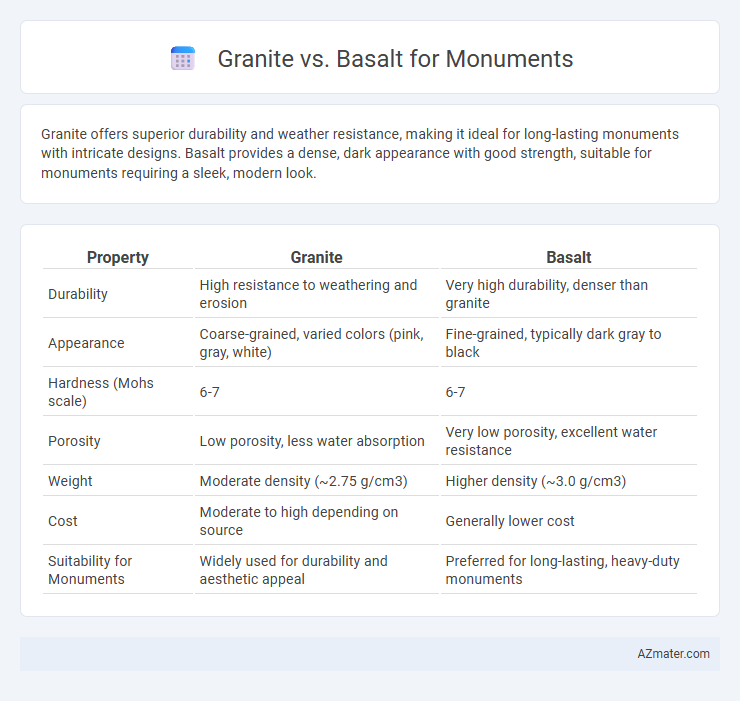Granite offers superior durability and weather resistance, making it ideal for long-lasting monuments with intricate designs. Basalt provides a dense, dark appearance with good strength, suitable for monuments requiring a sleek, modern look.
Table of Comparison
| Property | Granite | Basalt |
|---|---|---|
| Durability | High resistance to weathering and erosion | Very high durability, denser than granite |
| Appearance | Coarse-grained, varied colors (pink, gray, white) | Fine-grained, typically dark gray to black |
| Hardness (Mohs scale) | 6-7 | 6-7 |
| Porosity | Low porosity, less water absorption | Very low porosity, excellent water resistance |
| Weight | Moderate density (~2.75 g/cm3) | Higher density (~3.0 g/cm3) |
| Cost | Moderate to high depending on source | Generally lower cost |
| Suitability for Monuments | Widely used for durability and aesthetic appeal | Preferred for long-lasting, heavy-duty monuments |
Introduction to Granite and Basalt as Monument Materials
Granite and basalt are both igneous rocks widely used as monument materials due to their durability and aesthetic appeal. Granite, composed mainly of quartz, feldspar, and mica, offers a granular texture and a wide range of colors, making it popular for monuments requiring intricate carving and polished finishes. Basalt, characterized by its fine-grained texture and dark color, provides exceptional strength and weather resistance, ideal for robust and long-lasting memorial structures.
Geological Origins and Composition
Granite forms from the slow crystallization of magma beneath the Earth's surface, characterized by its coarse-grained texture consisting primarily of quartz, feldspar, and mica. Basalt originates from rapid cooling of lava at the Earth's surface, resulting in a fine-grained, dense rock composed mainly of pyroxene and plagioclase feldspar. The distinct geological origins and mineral compositions influence durability and appearance, making granite ideal for intricate monuments while basalt suits rugged, weather-resistant designs.
Physical Properties: Strength and Durability
Granite exhibits a compressive strength typically ranging from 130 to 240 MPa, making it exceptionally durable and resistant to weathering, which suits it well for monuments exposed to harsh environmental conditions. Basalt, with a slightly higher compressive strength of approximately 100 to 300 MPa, offers exceptional durability and resistance to abrasion, making it a strong candidate for long-lasting monumental structures. Both stones possess low porosity, but granite's interlocking crystal structure provides superior resistance to freeze-thaw cycles, enhancing its longevity in outdoor monuments.
Visual Appearance and Aesthetic Appeal
Granite showcases a coarse-grained texture with a rich variety of colors such as pink, white, gray, and black, offering a classic and elegant look ideal for monuments. Basalt features a fine-grained, dense texture with a consistent dark gray to black color, providing a sleek, modern, and minimalist aesthetic. The choice between granite and basalt depends on desired visual impact, with granite offering more pattern diversity and basalt delivering uniformity and subtle sophistication.
Weather Resistance and Longevity
Granite exhibits exceptional weather resistance due to its dense, coarse-grained structure, making it highly durable for monuments exposed to harsh environmental conditions. Basalt, though also durable, is finer-grained and can be more susceptible to weathering and erosion over time, especially in acidic rain or freeze-thaw cycles. The superior hardness and low porosity of granite contribute to its longer longevity, often surpassing basalt in monument preservation under diverse climates.
Workability and Carving Potential
Granite offers superior carving potential due to its coarse-grained texture and uniform hardness, enabling detailed and intricate monument designs. Basalt, being finer-grained and denser, provides excellent durability but presents greater workability challenges and limited carving precision. Choosing granite enhances creative flexibility, while basalt favors robustness with minimal detailing.
Maintenance Requirements
Granite requires less maintenance than basalt for monuments due to its higher resistance to weathering and erosion, ensuring longer-lasting durability with minimal care. Basalt's porous surface can absorb moisture, leading to potential staining and more frequent cleaning or sealing to prevent damage. The low porosity and hardness of granite make it an ideal choice for monuments requiring minimal upkeep in harsh environmental conditions.
Cost Considerations
Granite generally costs more than basalt due to its longer quarrying and polishing processes, but it offers superior durability and a more polished aesthetic for monuments. Basalt is typically less expensive and provides a dense, dark appearance with good weather resistance, making it a cost-effective option for budget-conscious projects. Consideration of installation expenses is also crucial, as granite's weight and hardness can increase labor costs compared to basalt.
Environmental Impact
Granite and basalt differ significantly in environmental impact when used for monuments. Granite extraction typically involves extensive quarrying, leading to habitat disruption and high energy consumption, whereas basalt, often sourced from volcanic regions, requires less drilling and energy-intensive processing. The longevity and durability of both materials contribute to reduced maintenance emissions, but basalt's abundance and lower carbon footprint make it a more sustainable choice for eco-friendly monument construction.
Choosing the Best Stone for Your Monument
Granite offers exceptional durability and a wide range of colors, making it ideal for monuments that require long-lasting elegance and resistance to weathering. Basalt, known for its fine-grained texture and dark, uniform appearance, provides a sleek and modern look but may be less versatile in color options. Choosing the best stone for your monument depends on the desired aesthetic, environmental exposure, and maintenance preferences, with granite often preferred for its strength and timeless beauty.

Infographic: Granite vs Basalt for Monument
 azmater.com
azmater.com